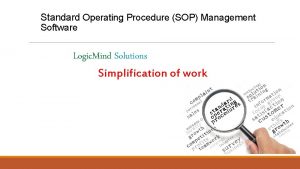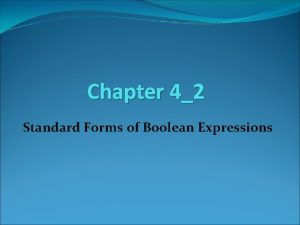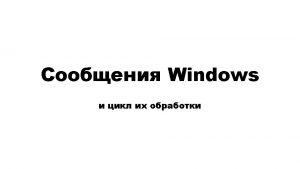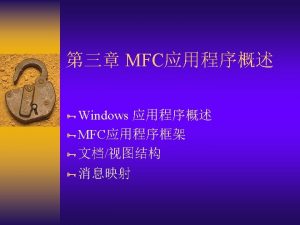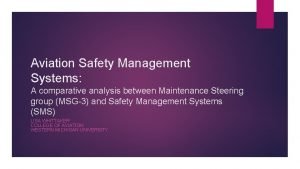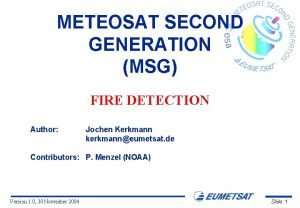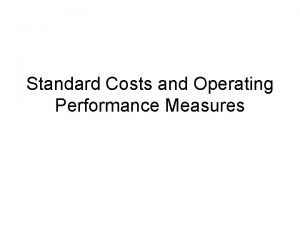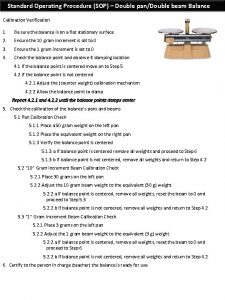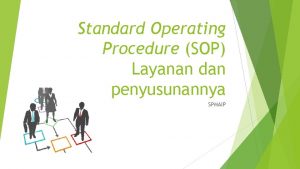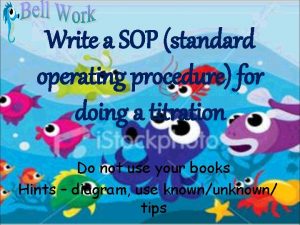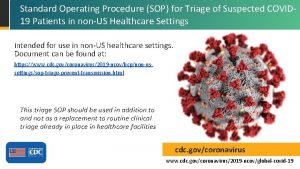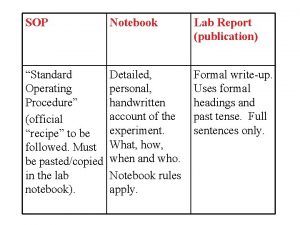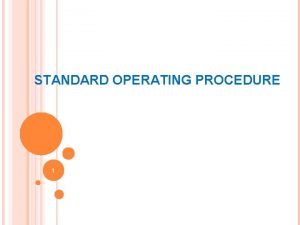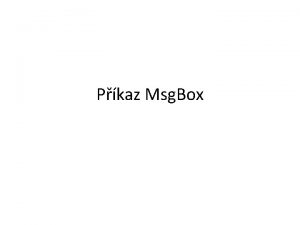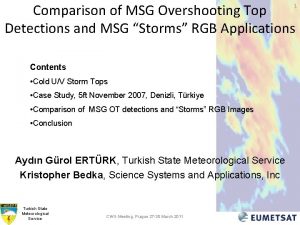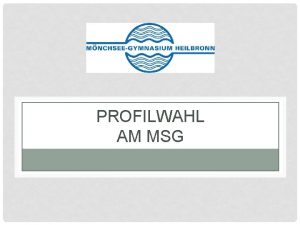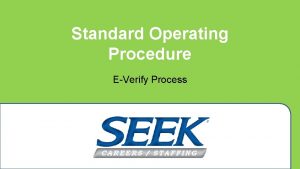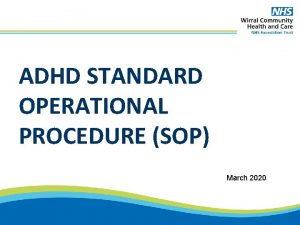STANDARD OPERATING PROCEDURE SOP DEVELOPMENT MSG LATANE I























- Slides: 23

STANDARD OPERATING PROCEDURE (SOP) DEVELOPMENT MSG LATANE I. GILLIAM 2 -183 CAV

PURPOSE To provide an overview of sop development and implementation Outline • • • SOP DEVELOPMENT SOP EXAMPLES PRE COMBAT CHECK PRE COMBAT INSPECTION CHECKLISTS 2 2

GETTING STARTED • DEFINITION • Standard Operating Procedure-established or prescribed methods to be followed routinely for the performance of designated operations or in designated situations. • -Meriam Webster

STAGES OF DEVELOPMENT STAGE 1. Determine optimal product a procedure should deliver. 2. Establish an optimal process for achieving the objective. 3. Explain in writing how to carry out the operating procedure RESULT The objective The operating procedure The standard operating procedure (the instructions)

INITIAL AUTHORING QUESTIONS What is the objective of the procedure to be established or revised (what will be the product of the procedure? What is the commander’s guidance about the procedure and its product? What is the instructional purpose of the SOP document (what will its users be able to do)? Who will read the document, and who will use the procedure? What background knowledge do SOP users have? To develop the procedure thoroughly and accurately, what information must be gathered and from what sources? What sources are considered authoritative or informative for this procedure? How can the SOP portal be used to facilitate developing the SOP? If a procedure already existed for achieving the objective, what were its strengths and weaknesses? If there is already a consensus for the optimal way to achieve the objective, what is the general statement of that method? Who must agree on the procedure? Who will sign to approve the SOP? By what methodology should the procedure be developed or improved? How should the new or revised SOP be vetted (both the procedure and the instructions)? With what existing documents, resources, organizations, or partners must the SOP align (regulations, policies, equipment, doctrinal or training literature, other)?

THINGS TO CONSIDER • What kind of SOP is this? Tactical SOP (TACSOP), Tactical Operations Center SOP (TOCSOP), Planning SOP (PSOP) • What echelon am I developing this SOP for? Battalion, Company, Platoon? • Do I have a copy of my Higher HQ’s SOP? A SOP should be nested with and not conflict with what is in the higher HQ SOP.

THINGS THAT SHOULD GO INTO A TACSOP- ( TO PROVOKE THOUGHT)

TABLE OF CONTENTS 1 CARD INTRODUCTION 100 Squadron's Role 101 Task Organization 102 References 103 Fundamentals & Principles 104 Uniform / Vehicle SOPs 105 Recognition Signals CHECKLISTS 200 Packing List 201 Weapon PCC / PCI 202 Weapons & Uniform Postures PLANNING 300 The Planning Process, TLP, MDMP 301 Graphic Control Measures 302 Graphic / Icon Management and Naming Conventions 303 Types of Rehearsals 304 Combined Arms Rehearsal Script 305 Rehearsal Briefing Format 8

TABLE OF CONTENTS 4 CARD REPORTS (NESTED IN BDE) 801 Reporting SOP listing 802 BLUE 1 SALUTE / SALTY 803 BLUE 2 SITREP 804 BLUE 5 CROSREP 805 BLUE 7 ROUTREP 806 BLUE 8 Closing report 807 BLUE 9 OBSREP 808 GREEN 2 Sensitive items report 809 YELLOW 1/1 A 810 YELLOW 2/2 A 811 YELLOW 3/3 A 812 YELLOW 4/4 A 813 YELOW 5 LOGSTAT 814 RED 1 PERSTAT 815 RED 2 Personnel Battle Loss Report 816 RED 3 MEDEVAC Request 817 UXO / IED report AIR ASSAULT OPERATIONS 900 Air Assault Operations 901 LZ / PZ Operations 902 Air Assault Planning 903 Air Mission Brief Format 9

Table of Contents 5 CARD FIRES AND EFFECTS 1000 Target Block and FSCM Naming Conventions 1001 Risk Assessment Distances 1002 Artillery and Mortar Ranges 1003 Planning ranges 1004 Air to Ground Integration 1005 Conversion Card 1006 Targeting Process 1007 Target List worksheet 1008 Fire Missions INTELLIGENCE 1100 Collection Management / IC Sync matrix 1101 CCIR to PIR Breakdown 1102 Processing EPWs 1103 Sensitive site Exploitation 1104 Troop Fusion Cell SOP SUSTAINMENT 1200 Organization 1201 Concept of Sustainment 1202 Classes of Supply and Planning Considerations 1203 Medical Support Operations NOTES 1300 Notes UNCLASSIFIED 10

11 104 Introduction Uniform / Vehicle SOPs JRTC Battle roster number= First 2 initials last name, last 4 of DOD ID Body Armor w/plates for LFX ACH with camo and NVG mount Casualty Card pre filled out, laminated left shoulder pocket Ballistic Eye Protection FLC w/IFAK on lower left side, 4 magazines, pouches Personal weapon NVGs (tied down) Canteen cup tie down Camelbak (on back) Gloves Pro Mask (MOPP lvl dependent) ALL Scouts carry map, compass and protractor. They also carry pen and paper. Standard Uniform UNCLASSIFIED ALL Scouts are encouraged to carry camouflage. Face paint, netting with burlap to conceal self and equipment.

104 Introduction Uniform / Vehicle SOPs (continued) Front view: Rolled Camo Net under turret Litter on hood Side view: CL IV and MOLLE secured in trailer or cross loaded to other trucks 550 Cord netting to add camouflage to trucks. (doesn’t stop function) UNCLASSIFIED 12

13 PCC/PCI Know the Difference • Before each JRTC rotation, leaders at brigade, battalion and company levels develop their lists of key tasks and training objectives. These objectives usually include PCCs and PCIs, typically worded, “Our unit will conduct PCCs and PCIs to standard. ” Their recognition of the importance of PCCs and PCIs is clear, but less clear is what those standards are or how the two activities differ. UNCLASSIFIED

14 PRE COMBAT CHECK (PCC) • Pre-combat check -a formal check by an individual Soldier to ensure that he or she is prepared to execute a mission, and that all team and squad equipment is prepared and in working condition Should occur in step 4 of the Troop Leading Procedures (TLP). (MCo. E) UNCLASSIFIED

15 PRE COMBAT INSPECTION (PCI) • Pre-combat inspection (PCI) • formal check conducted by platoon leaders to ensure that Soldiers have conducted their PCCs, and that all equipment necessary for a mission is present and serviceable. • Should occur in step 8 of the Troop Leading Procedures (TLP). (MCo. E) UNCLASSIFIED

16 IMPLEMENT CHECKLISTS FOR INSPECTIONS IN YOUR SOP • PCI SOPs should establish the minimum standards for different mission types, with special emphasis on mission-essential equipment. Further, leaders should be coached to make their PCI intentions clear during the warning order or operational order, enabling subordinate leaders to ensure their PCIs address key issues first. • Checklists drive a proper Pre-Combat Inspection, and give the individual Soldier and Team/Squad Leader a standardized approach to expectations and standards. UNCLASSIFIED

17 Plan for Pre- Combat Inspections • When building PCIs into the timeline, they must be planned with enough time to fix any deficiencies should they be found. Too often, when units do manage to conduct PCIs, they force themselves to delay their mission to fix issues that are discovered. It is better to find these issues than not find them, but if fixing them requires desynchronizing a larger operation, the solution may be worse than the problem. The answer is to plan accordingly. Planning a PCI mere minutes before execution indicates a desire to go through the motions but reveals little thought put into the activity’s actual purpose or utility. UNCLASSIFIED

18 Examples of Checklists • Below are some examples of checklists from the 2 -183 CAV TACSOP (V 2) MAR 2020. These examples, apply to that unit. They may apply to your unit, but they should be nested with the unit’s SOP and followed by unit members and leaders at all echelons. UNCLASSIFIED

200 Checklists Packing List Example Commanders may modify the packing list based on the season and METT-TC. The following is “A Way” to provide an example of packing to Leaders. Items Worn -Uniform -Dog Tags -CAC Card -Casualty Card Assault Pack • Job Specific equipment • Extra ammo • Supplies Rucksack • Extra uniform • Seasonal gear • Woobie or sleep system • Extra socks • E Tool Duffel Bag • “Resupply” method • Extra uniform • PTs • Barracks Items Commanders may modify the packing list based on the season and METT-TC. EXERCISE Common Sense and eliminate unused or unnecessary equipment. Poncho and poncho liner during the summer vs the whole sleep system. Fight Light. UNCLASSIFIED 19

201 Checklists Weapons PCC / PCI (1 of 3) M 9 / M 17 q Serviceable holster w/ lanyard attached q Passes function check q All magazines are serviceable and properly feed and release from weapon q Adequately lubed M 4 q q q q Passes function check M 68/ACOG/ PEQ-15 & Tac-Light secured IAW SQDN SOP PEQ-15 w/pressure switches bore sighted and zeroed x 2 AA batteries & x 1 M 68 battery in pistol grip of in pistol grip with tape All magazines are serviceable and properly feed and release from weapon Adequately lubed Serviceable sling M 320 q Passes function check q Laser range finder functioning q PEQ-15 w/pressure switches bore sighted and zeroed q Day/Night Sight & Leaf sight operational q M 320 ammo pouches present and serviceable M 249 q Passes function check q PEQ-15 secured q M 68/ACOG/PEQ-15 w/pressure switch bore sighted and zeroed q x 2 100 rd assault pouch present and serviceable q Serviceable sling (Bulldog Sling ideal) UNCLASSIFIED 20

201 Checklists Weapons PCC / PCI (2 of 3) M 240 B q Passes function check q PAS-13/PEQ-15/M-145 mounted / secured / borelight zeroed q Tripod complete q Spare barrel / case / BII complete q T&E / Pintle q Ammunition bag q Acetated Range Cards q Serviceable sling M 2 q q q Leaders check headspace & timing (if required due to model) Passes function check PAS-13/STORM / secured / borelight zeroed M 3 Tripod complete Spare barrel and bag complete (glove) T&E / Pintle Acetated Range Cards Head Space & Time Gauge Carrying Handle MK 93 serviceable and pins lightly lubed T&E Present, zeroed, and serviceable CLP present MK-19 q BEFORE” PMCS TM 9 -1010 -230 -10 STANDARDS ALWAYS! q Passes function check q M 3 Tripod / Gun cover / Cleaning Kit q T&E / Pintle / MK 93 w/ pins q Ammo Tray / Feed Throat / Brass Catcher Bag q LSAT present q Acetated Range Cards AT-4 q q q Front/rear membrane present and serviceable Transport safety pin and lanyard present Front/rear sight posts present and spring loaded No cracks or damage to tube body PEQ-2/PEQ-15 mounting bracket TOW q q q q Tripod (optional/training) Traversing unit Day / Night sight operational Collimator Cables / BPC / Spare Battery Box Rechargeable batteries Lens paper / soft brush / equipment cover Acetated Range Cards JAVELIN q Command Launch Unit (CLU) q Extra Battery Cooling Unit (BCU) q Acetated Range Cards q Sling q Lens paper/ rag MAAWS M 3 TBP UNCLASSIFIED 21

202 Checklists Weapons & Uniform Postures Uniform Status. 1. Uniform Posture Level 1 (U 1). A. Duty uniform (ACU or IPFU), weapon, ballistic goggles, and one magazine of ammunition. B. Normal uniform at MOPP 0 (available within two hours). 2. Uniform Posture Level 2 (U 2). A. Duty uniform, Kevlar, Interceptor body armor, full basic load of ammunition, and ballistic goggles. B. Temporary wear of elevated posture with a time frame. C. MOPP level dictated by higher. 3. Uniform Posture Level 3 (U 3). A. Same as U 2 posture, but maintained until further notice. B. MOPP level dictated by higher. 4. Uniform Posture Level 4 (U 4). A. Same as U 3 posture with combat earplugs and AMBER arming stance. B. MOPP level dictated by higher. 5. Uniform Posture Level 5 (U 5). A. Same as U 3 posture with combat earplugs and RED arming stance. B. MOPP level dictated by higher. Ammunition Status. Red: Round chambered and magazine loaded. Yellow: Magazine loaded and chamber clear. Green: Magazine out and chamber clear. Weapons Control Status. Hold: Engage only if engaged or ordered to do so. Must have PID. Tight: Can engage if target is positively identified as enemy. Free: Can engage unless target is positively identified as friendly. NOTE: Do not carry your weapon on anything but safe – you will transition only when prepared to fire. UNCLASSIFIED 22

23 REFERENCES • ATP 3 -90. 90 • 2 -183 CAV TACSOP UNCLASSIFIED
 Standard operating procedure software
Standard operating procedure software Darley and latane decision tree?
Darley and latane decision tree? Pos to sop conversion
Pos to sop conversion Ad msg wnd
Ad msg wnd Matt 11 28-30 msg
Matt 11 28-30 msg John 20 message
John 20 message Exodus 3 message
Exodus 3 message John 2 msg
John 2 msg Tagmsg
Tagmsg Msg timeline
Msg timeline Mhelpdesk msg
Mhelpdesk msg Jeremiah 1:5 msg
Jeremiah 1:5 msg Evolution of safety thinking
Evolution of safety thinking 2 peter 3:11-18
2 peter 3:11-18 Ephesians 2 19 22
Ephesians 2 19 22 Colossians 3:1-2 msg
Colossians 3:1-2 msg Matthew 5:13-16 the message
Matthew 5:13-16 the message Msg foundation case study
Msg foundation case study Msg fire
Msg fire Lectio divina ciclo a
Lectio divina ciclo a Organic food additives
Organic food additives Eva msg
Eva msg Psalm 91 in english
Psalm 91 in english Standard costs and operating performance measures
Standard costs and operating performance measures
